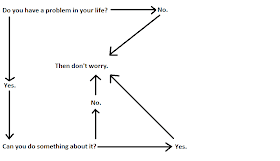Always in comedic works of literature we encounter a particular phenomenon. It's that which occurs to Trygaeus, the protagonist of Aristophanes' play Peace. The play opens with Greece plunged into the midst of war and all its suffering. You may remember from an earlier post that the Epic genre followed three stages of plot development. The same is true of Comedy, though in Comedy, rather than the stages being lived through as the hero's Battle, Journey, and Homecoming, in Comedy, these same ideas and qualities are lived through by the representation of the story's world as one which is Infernal, Purgatorial, and Paradisal. War is nothing if not hellish.
As the play begins, Trygaeus turns the world into a Purgatorial one by hatching a plan to end the war and return peace to Greece. The farmer has two of his servants mash dung into cakes and feed them to a beetle, the beetle he feeds til it is large enough to carry a man and rides to heaven to plead his case to the gods.
The goddess Peace (the incarnation of the principle) has been locked away by War. Much of the rest of the play consists of Trygaeus stirring up his fellow Greeks to pull away the giant stones with which War has plugged Peace's cell. It is hard work, and takes the full effort of everyone. This is the truth of peace, joy, and paradise. It can only be had by the consistent and loving work of everyone involved. We must cooperate in God's good work, we must become like him in loving action if ever we are to enjoy his bliss and, more than that, infect the world with it.
Of course, Trygaeus and the Greeks are successful, releasing not only Peace but her companions Festival and Harvest as well, (comedy, like God, always gives more than expected, more than deserved) who then set off for Athens with Trygaeus. The play ends, as all Comedies do, with a wedding, here that between the farmer Trygaeus and Harvest. Obviously, this is an analogy for the time of peace bringing a good harvest to the farmers, and, as a result, a cause for celebration.
Finally, after a council, a festival of sacrifice to Peace on the advice of the words of the poet Homer, the farmer and his Harvest are wedded, at the end of which Trygaeus invites the people of Athens to celebrate with he and his new bride, saying, "Follow me, sirs, if ye will, / And of bridecakes eat your fill." The grace of the comedic world has converted the dung cakes from the beginning of the play into bridecakes; i.e., a marriage feast, that which Revelation speaks of as "the marriage supper of the Lamb," (Rev. 19:9).
It is through dung, the most humble, prosaic, and down-to-earth thing one could think of, that Trygaeus gains entry into Heaven. It is always through the lower that the higher comes to us. It is through matter that we have form, through bodies that we have souls. It is through the action of God humbling himself that we are redeemed: "Though he was in the form of God, [Christ] did not count equality with God a thing to be grasped, but emptied himself, taking the form of a servant, being born in the likeness of men. And being found in human form he humbled himself and became obedient unto death, even death on a cross," (Phil. 2:6-8). It is through such commonplace things as water, oil, bread and wine that the grace of this redemption is transmitted to us through the Church.
As I've said before, the heroes of our faith are those who never receive any glory, any praise for their good deeds. They are the ones who do the little things day in and day out for the good, the true, and the beautiful and never complain. The families who eat bologna sandwiches one night a week so they can give some money to the poor. The mothers who somehow manage to raise seven children almost singlehandedly and still make three meals a day. The fathers who work ten hour days and come home to six more of crying kids and chores.
It is humility which puts us close to God. We cannot build a ladder to heaven, nor can be build a tower (cf. Gen. 11). We cannot conquer heaven with our devices or our cunning. "Humble yourselves therefore under the mighty hand of God, that in due time he may exalt you," (1 Pet. 5:6). As Christ himself said, in his kingdom, "the last will be first, the first last," (Matt. 20:16).












































